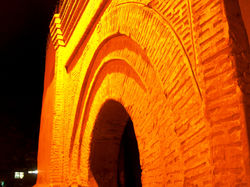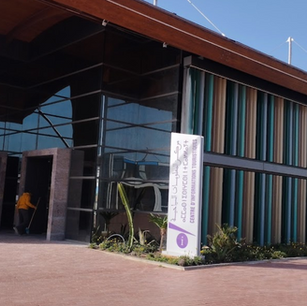Le Jardin aux Etoiles
Riad between Agadir and Taroudant, in southern Morocco
Holiday rental with a resident of Swiss nationality
Taroudant: the most beautiful walls of Morocco
Nicknamed "little Marrakech", Taroudant has a rich history two thousand years old. A thousand years older than the Ocher City, it is also surrounded by more spectacular, visible and complete walls. These ramparts are among the most beautiful in North Africa. You can get there in about 40 minutes by car. Take the National road which passes through the center of Ouled Teima, rather than the express road, which is longer.
Made of earth, lime, gravel and red bricks, the magnificent walls that surround Taroudant are a unique attraction. They are complete, but constantly under reconstruction, in one place or another, as soon as they deteriorate under the combined effect of the sun, pollution and rain (it rarely falls...).
You can go around them without interruption as long as a road runs completely along them. It is thus free to stop at any place that seems interesting.
A very pleasant form of visit consists of taking one of the horse-drawn carriages which offer a circular discovery, giving the opportunity to see, for example, the late tannery installed just outside the walls (see the video at the bottom of this page). Negotiate the price of the carriage ride at the start!
Our advice for a horse-drawn carriage ride: Boujemâa (ex-employee of the Knie circus), 00212 6 26 18 58 67

A pleasant way to tour the walls of Taroudant.

Smells and colours...

It is located at the entrance to Taroudant, on the left as you arrive from the Jardin aux Etoiles.

Present-day Morocco was an important part of this Berber kingdom supported by Rome.

His bust was discovered in Volubilis. It is now on display at the Rabat Archaeology Museum.

Two centuries before the beginning of our era, the first known Amazigh king, Massinissa, founded the kingdom of Numidia with the help of the Romans.

Married to Cleopatra's daughter, he ruled an even larger territory than Massinissa, in the name of Rome. Un soulèvement berbère obligea les Romains à se retirer du Maroc actuel. Les Vandales, qui envahissent le Maghreb au Ve siècle, ne parviennent pas davantage à soumettre les Imazighen.

Raised by Octavia, he became a friend of Augustus, who gave him the province of Mauretania in 25 BC. Born in 50 BC, he died in 23 BC. On the reverse of this denarius is the head of his wife Cleopatra Selene, daughter of the g
A fortified outpost of the Roman army
Most historians agree that almost 2000 years ago, Taroudant bore the name Vala, which would come from that of a deified Roman or Syrian woman, representing beauty. It was a fortified outpost of the Roman army deep in enemy territory. The Berbers who populated it were still largely nomadic and engaged in a merciless struggle against the Romans. Vala was inthe Gétules area, located in the south of Tingitane Mauretania.
The Roman presence in present-day Morocco was not negligible. The ruins of Volubilis are there to testify to it with brilliance.
The name "Vala" is still popular in Taroudant. An association named Opéra des arts expressifs organized in the town of Soussthe first Vala Meeting for dance and expression for young hip-hop lovers. A restaurant located at the entrance of the city is called Vala. It's traditional...and quite good.
Led by Aziz, a construction company also bears this denomination. The same is true of a metalwork and one private school of hairdressing and aesthetics. On Facebook, there is an Association Gnaoua Vala - Taroudant which brings together traditional musicians. The group Vala Wind makes good music and thus pays homage to its city.
Six kilometers of ramparts
The ramparts measure six kilometers in length. They allow passage through nine arched gates of Moorish architecture, arranged mainly at the cardinal points. No less than 130 towers and 19 corner bastions intertwine there, which made the city an impregnable citadel throughout its long history. The small fortified Berber town which succeeded the Roman outpost much later, came under the control of the Almoravids in the 11th century. It regained its freedom at the time of the Almohads, before its destruction in the 14th century by the Merinids.
Founder of the Saadian dynasty, Mohammed Cheikh Saâdi made it his capital and a base for his offensives against the Portuguese settled in Santa Cruz du Cap Ghir, that is to say the current Agadir. Driven by its exports of sugar cane produced in the Souss Valley, as well as its status as a caravan center, Taroudant lived through a golden age until the 18th century.
This prosperous period was interrupted when the port of Agadir was closed in 1760, having been supplanted by that of Essaouira. Centuries of slump followed. The development of tourism during the second half of the 20th century finally restored the luster to the former Saadian capital.
A museum that remains to be imagined
The museum that would explain the origin of the ramparts, their strategic importance through the centuries and their architectural fragility remains to be imagined. The Palace of Claudio Bravo, an eminently private work if ever there was one, makes up for the shortcomings of the public sector. It is a place to visit first and foremost by any visitor to Souss and especially Taroudant.
The recent restoration of the enfilade of the doors of the Kasbah shows the right path that the Rwandan authorities in charge of tourism should take. Dilapidated up to now, they now shine with new brilliance in the Roudanian night. A beautiful work of craftsmanship has been achieved. The main door is called Bab Sedra, that is to say "the door of the sedra", from the name of the small typical Moroccan shrub which gives berries, fluffy when dried, and which are eaten. Others claim it to be the Cedar Gate.
The ceiling is built according to the traditional method which uses an assembly of perpendicular wooden beams found throughout the region. There would already be enough here to explain, through panels, some of the aspects of the Roudani cultural heritage!
At the end of 2015, a Space of memory of the Resistance and the liberation of Morocco opened to the north of the city, near the Polydisciplinary Faculty. But, despite the passing inclinations of associative circles, the local authorities seem unable to bring about the great achievement that Taroudant deserves. And yet, the Dar El Baroud Palace would be likely to offer the city the useful destiny, see the prestige it lacks so much.
As in the whole of the Kingdom, Jews left the region when Morocco gained independence, even as the newly created State of Israel called them. The ancient Jewish community is today in search of its identity in Taroudant and the surrounding area. You can also still visit the Jewish cemetery, as well as the old synagogue, transformed into an antique shop named Aladdin, very beautiful and quite expensive.

They are positioned at regular intervals throughout the enclosure.

As they appear when you arrive from the Jardin aux Etoiles, having taken either the main road or the expressway.

Cet hôtel et son excellent restaurant sont adossés aux murailles

Recently renovated.

As it was at the beginning of the 20th century.

They are characteristic of the walls of Morocco. Photo Martine Hervé

A pleasant way to discover the walls of Taroudant.

Here a wooden door and a window with wrought iron typically Berber.
Map of the city of Taroudant. Click to enlarge!
Not as nice on the inside as it is on the outside
For a visitor, it is not easy to navigate inside the walls of Taroudant. The Google Maps map above gives the keys to the five-door city which claims 80,000 inhabitants. Click to enlarge.
The very typical character of thisbig town lively appeals to many visitors. In the eyes of many, Taroudant is unfortunately not as beautiful from the inside as it is from the outside. Some places, like the open-air parking lot south of Assarag Square, which we discuss below, are filthy.
The visit to the Berber souk, near Tamalklat Square, is nevertheless perfectly worthy of a visit, as shownone of the videos below.
Another curiosity worth seeing: the tannery, its mysteries and the many operations that take place there. You can find good deals there..
Many guest houses have been built in recent decades inside the ramparts. However, they are not visible at first glance. In Morocco, we hide what we have most precious, and Taroudant is no exception to the rule.
The center of the city
Assarag Square is the center of the city and of life. You reach it, in a straight line, through the west gate, named Targhount. It may happen that by car you find yourself stuck in a very small street, obviously not equipped with the "dead end" signal, which will leave you no other choice than a delicate reverse gear. But we will help you: there will always be a few Moroccans ready to help you and give you more or less wise advice.
All the administrative buildings, which are contemporary and often quite prestigious, as well as most of the banks were built outside the ramparts, on the road to Ouarzazate. There it is definitely easier from a traffic point of view, but less typical.
Farah Dibah and Jacques Chirac
Quite a number of personalities live all year or part of it in the city with the ramparts. Among them: Farah Diba, ex-empress of Iran, "queen" of Taroudant.
Former French President Jacques Chirac and his wife Bernardette have long been guests of the Gazelle d'Or. They then frequently stayed in Agadir, before their health deteriorated, in 2016.
Taroudant and its surroundings have served as a setting for filming. The famous comedy Ali Baba and the 40 thieves, with Fernandel, was filmed mainly in the palm grove very close to Tiout. More dramatic, Agadir-Bombay, which deals with the delicate subject of prostitution in Morocco, took place not only in Agadir, but also in Taroudant, the city of origin of the main character, Imane, and the father of the Franco-Moroccan director Myriam Bakir.
Our recommendations in and around Taroudant















